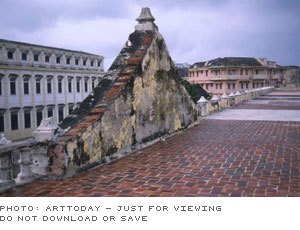|
In his sonnet “To my Native City,” Luis Carlos Lopez, a poet from Cartagena, compared the kind of love he felt for his city to the kind of love one feels for old shoes. He seems to have truly reached his countrymen’s hearts. Today, the Monument to Old Shoes, an object of local pride, is a landmark in Cartagena and certainly a must-see for tourists.
Pedro de Heredia founded Cartagena of the Indies in 1533 as an enclave for the domination of the newly discovered territory, and as a port for commercial exchange between the metropolis and its colonies. During the fire of 1522, many primitive homes built of palm and cane were destroyed. Because of this tragedy, and also due to the commercial boom of the port city, an astounding urban development was begun that can be witnessed today in the city’s monumental architecture. Cartagena of the Indies suffered over 14 attacks by pirates and corsairs. During the 17th century it was a pillar in the economy of the Nueva Granada Viceroyalty. In the early 19th century it became the focus of the American fight against Spanish dominance.
On November 11, 1811, Cartagena declared its absolute independence. The following century, the Heroic City slowly became less important, until an oil source in a nearby valley of the Magdalena River, discovered in 1917, restored its vitality. Industrial activity, a historic urban setting, the presence of the Caribbean Sea, and the spontaneous joy of its people have made and kept Cartagena of the Indies one of the most exceptional cities in America. The city was fortified to defend the Crown’s treasures: twelve miles of walls 50 feet thick testify to it. Among the city’s historic sites stand out the Santo Domingo Bulwarks, La Merced, Santa Clara, Santa Catalina, San Lucas, and San Pedro Martyr; also, the Getsemaní Wall, the San Juan of Manzanillo Forts, Santa Cruz of Castillogrande, San Felipe, and El Pastelillo; the Vault Barracks, the Bocachica defensive complex, and the San Fernando Castle.
But there are more than just military constructions in Cartagena that still survive: churches, mansions, and government offices adorn the city left and right, all with a historic legacy and a great number of legends. The best known are the Cathedral, San Pedro Claver, the Door of the Clock, the Museum of Gold, the House of the Marquis of Valdehoyos, the Heredia Theater, the Santa Clara Convent, the San Francisco Cloister, and the Convent of the Poop. We can find history in every corner, in every balcony, in every alley of this previously walled city. But Cartagena is not a city of the past, it’s a city of the present and future: due to its historic value, it lives today in full splendor. History, adventure, romance and tradition, all wrapped up in joy and hospitality: such is Cartagena of the Indies. Cartagena de Indias, an example of the best of the latin spirit. |
|
|
 Can
a city identify itself with old shoes?
Can
a city identify itself with old shoes?